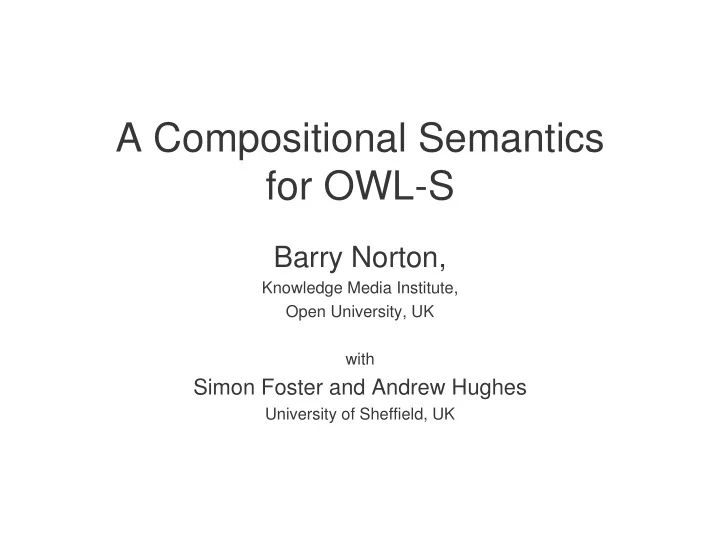

A Compositional Semantics for OWL-S Barry Norton, Knowledge Media Institute, Open University, UK with Simon Foster and Andrew Hughes University of Sheffield, UK
Introduction • OWL is Web Ontology Language , proposed to W3C for Semantic Web • OWL-S is ‘service ontology’, defining Semantic Web Services • OWL-S process model describes formation of services by composition • OWL-S process model therefore defines orchestration via workflow
Context • OWL-S process model aims to capture common subset of workflow features whereas • WS-BPEL ends up with an all-inclusive superset of features
More Context • YAWL attempts to capture all workflow ‘patterns’ in Petri net dialect whereas • Much process calculus-like work directly models specific features
‘Composability’ vs. Compositionality • ‘Composability’ implies: – Existing (semantic) results should extend to new syntactic features (not so for direct process model) • Principle of compositionality: – Semantics of (syntactic) composite should derive from semantics of components (not so for Petri nets)
Aims • Create a compositional model for OWL-S process model in general process algebra but • Composable? • Compositional through what equivalence?
Approach • Take existing model of coarsely (sequentially) interleaved dataflow (CONCUR03), which is one of OWL-S composite process types • ‘Compose’ other OWL-S process types • Apply existing notion of behavioural equivalence (temporal observation congruence)
(Generalised) OWL-S Processes Process ::= AtomicProcess … | CompositeProcess CProcess … CProcess ::= AnyOrder PerformanceList | Sequence PerformanceList | Split PerformanceList | SplitJoin PerformanceList | ChooseOne PerformanceList | IfThenElse Performance Performance | RepeatWhile Peformance | RepeatUntil Performance PerformanceList Performance | PerformanceList; Performance | PerformanceList; Connect … Performance ::= Perform Process
Existing Model • Take automata describing interfaces of components • Compose agent representing participation in global synchronisation to form instance • Compose instances together, in model aware of communication-style (local) and global synchronisations • Compare for conformance to interface (automaton) assigned to composite
‘Interface Automata’ • Generally: r e /ready execute a c d … input b … … /output
Instantiation � n � c n r e c n a n a c … … b n � b d d n … d n …
Basis (Regular CCS) …
Basis (CCS) …
+ Deterministic Time …
+ Maximal Progress ( ≈ TPL) …
+ ‘Stalling’(=PMC’s 0 )…
+ Multiple Clocks (a la PMC, CSA)…
+ Hiding (= CaSE)
Compositional Broadcast • Broadcast • Connection
Composition � m … � cn 1 t t � n � n 2 r e 1 r e … cn an 2 1 …
Conclusion • Modulo small extension, calculus allows ‘composition’ of OWL-S process types • Theoretical results: – Temporal observation congruence holds – Full abstraction holds – To do: • extension of algebraic theory • Practical results – Implementation in Haskell – To do: • extend partition refinement • implementation in LISP
Further Work • Fix cashew-s as a rich language for choreography (WSMO insists service interface provide both orch & chor) • Establish expressiveness of cashew-nuts to give semantics to orchestration and choreography • Investigate temporal observation congruence as a conformance test between orch & chor • Now part of DIP (European Integrated) Project, therefore providing input to WSMO
Recommend
More recommend